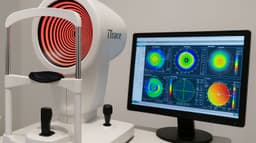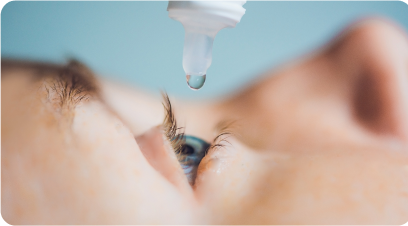
Myopia Vs Hyperopia
Myopia, commonly known as nearsightedness, is a refractive error of the eye where distant objects appear blurry, while close objects can be seen clearly. This occurs when the eyeball is slightly longer than usual, causing light rays to focus in front of the retina instead of directly on it. As a result, individuals with myopia often have difficulty seeing objects in the distance without corrective lenses.
On the other hand, hyperopia, or farsightedness, is another refractive error characterised by difficulty seeing objects up close. In hyperopia, the eyeball is shorter than average or the cornea is too flat, causing light to focus behind the retina rather than on it. This leads to blurry vision for close objects, and in more severe cases, for objects at various distances. People with hyperopia might need to exert extra effort to focus on close tasks, such as reading, and may experience eye strain or headaches.
Causes & Symptoms
Myopia and hyperopia are two common refractive errors of the eye, each characterised by a different pattern of vision impairment:
- Myopia (Nearsightedness):
- Definition: Myopia, often referred to as nearsightedness, is a condition where a person can see objects up close clearly, but distant objects appear blurry.
- Cause: It usually occurs when the eyeball is longer than average, or the cornea is curved too much. This causes light to focus in front of the retina rather than directly on it.
- Symptoms: Difficulty seeing distant objects, squinting to see clearly, and a tendency to hold objects closer to the face.
- Correction: Corrective lenses like glasses or contact lenses with a negative prescription are used to shift the focus of light onto the retina.
- Hyperopia (Farsightedness):
- Definition: Hyperopia, also known as farsightedness, is a condition where distant objects are seen more clearly than close objects.
- Cause: It typically occurs when the eyeball is shorter than average, or the cornea is flatter than usual. This results in light focusing behind the retina rather than directly on it.
- Symptoms: Difficulty with close-up tasks like reading, eye strain, and potential headaches after prolonged work especially using screens.
- Correction: Corrective lenses with a positive prescription are used to bring the focus of light forward onto the retina.
In summary, myopia affects distance vision, making faraway objects appear blurry, while hyperopia affects close-up vision, making nearby objects appear blurry. Both conditions are common and can be corrected with glasses, contact lenses, or in some cases, through surgical procedures. It's important to have regular eye exams to detect and manage refractive errors for optimal vision health.

Using Technology For Myopia & Hyperopia
Laser eye surgery is a viable option for correcting both myopia and hyperopia:
- Myopia (Nearsightedness):
- Laser Procedure: For myopia, a type of laser eye surgery called LASIK (Laser-Assisted In Situ Keratomileusis) is commonly used. During LASIK, a thin flap is created on the cornea, and then a laser is used to reshape the underlying corneal tissue. This adjustment corrects the focusing of light onto the retina, addressing the myopic condition.
- Hyperopia (Farsightedness):
- Laser Procedure: Hyperopia can also be treated with LASIK. In this case, the cornea is reshaped to increase its curvature, allowing light to focus more accurately on the retina for clear vision at various distances.
It's worth noting that while LASIK is highly effective, it may not be suitable for everyone. Factors like the degree of refractive error, corneal thickness, and other individual considerations play a role in determining the eligibility for the procedure. Therefore, a comprehensive evaluation by an ophthalmologist or refractive surgeon is essential to assess whether laser eye surgery is a suitable option.
Additionally, there are other types of laser eye surgery, such as PRK (Photorefractive Keratectomy) and SMILE (Small Incision Lenticule Extraction), which may also be considered based on the specific needs and circumstances of the patient.

Facts & Figures
Myopia (Nearsightedness)
In the UK, myopia is a common refractive error, and its prevalence has been steadily increasing over the years, especially among children and young adults. As of 2023, it was estimated that around 30% to 40% of the UK population had myopia to some degree.
Hyperopia (Farsightedness)
Hyperopia is also a common refractive error. The prevalence of hyperopia in the UK is lower compared to myopia. As of 2023, approximately 20% of the population was estimated to have hyperopia.
Other Eye Conditions
Presbyopia
Presbyopia is a condition where the ability to focus on close objects diminishes with age. It affects virtually everyone as they get older. By the age of 45, most people experience some degree of presbyopia.
Astigmatism
Astigmatism is a condition where the cornea or lens is irregularly shaped, causing distorted or blurred vision. It often occurs in combination with myopia or hyperopia. The prevalence of astigmatism varies but can be quite common.
7 Interesting Points About Myopia And Hyperopia
- Genetic Factors
- Both myopia and hyperopia can have a genetic component. If one or both parents have a refractive error, there is an increased likelihood that their children may develop a similar condition.
- Age of Onset
- Myopia often manifests during childhood and tends to progress until the late teens or early twenties. Hyperopia, on the other hand, may not become apparent until later in life, particularly as the eye's natural lens loses flexibility (a condition known as presbyopia).
- Impact on Education
- Myopia, especially when uncorrected, can significantly affect a child's performance in school. It may lead to difficulty seeing the board, reading, or participating in activities that require clear distance vision. Hyperopia, if significant, can impact close-up tasks like reading or computer work.
- Risk of Eye Conditions
- Myopia, particularly high myopia, is associated with an increased risk of certain eye conditions such as retinal detachment, cataracts, and glaucoma. Hyperopia may also have specific associations, particularly in severe cases.
- Prescription Range
- Myopia and hyperopia are measured in diopters. Myopia is represented by a negative number (e.g., -2.00), indicating the degree of nearsightedness. Hyperopia is represented by a positive number (e.g., +2.00), indicating the degree of farsightedness.
- Correction Options
- In addition to laser eye surgery, both myopia and hyperopia can be corrected with eyeglasses and contact lenses. Additionally, there are specialised contact lenses designed for specific types and degrees of refractive error.
- Prevalence by Region
- The prevalence of myopia and hyperopia can vary by region and population. For example, in some Asian countries, the prevalence of myopia is exceptionally high, which has led to increased public health awareness and interventions.
Remember that regular eye examinations are crucial for early detection and appropriate management of refractive errors.

Key Differences Between Myopia And Hyperopia
| Aspect | Myopia (Nearsightedness) | Hyperopia (Farsightedness) |
|---|---|---|
| Definition | Difficulty seeing distant objects clearly | Difficulty seeing close objects clearly |
| Cause | Eyeball is longer or cornea is too curved | Eyeball is shorter or cornea is too flat |
| Focus of Light | Light focuses in front of the retina | Light focuses behind the retina |
| Common Symptoms | Squinting, holding objects close | Difficulty with close-up tasks, eye strain |
| Correction | Negative prescription glasses or contacts | Positive prescription glasses or contacts |
| Age of Onset | Often in childhood, may progress | Can become apparent later in life |
What Happens Next?
If you or a family member experiences any symptoms of vision impairment, it's crucial to take proactive steps towards addressing it. Blurred vision, difficulty focusing on objects, or persistent eye strain should prompt a visit to an eye care professional. Seeking timely advice ensures early detection and appropriate treatment. In London, My-iClinic stands as a leading institution specialising in eye care and vision correction. With a team of expert ophthalmologists, we offer a range of services tailored to individuals of all ages. From myopia and hyperopia correction to treatments for various eye conditions, My-iClinic is dedicated to helping families achieve optimal vision health.
Located in the heart of London, My-iClinic provides a convenient and accessible option for those seeking exceptional eye care. Our comprehensive approach encompasses cutting-edge technology, personalised treatment plans, and a commitment to patient well-being. My-iClinic's experienced team is equipped to cater to the unique needs of every family member. Don't let vision issues hinder your quality of life. Take the first step towards a clearer and more vibrant future.
Find out more by Speaking to our team









